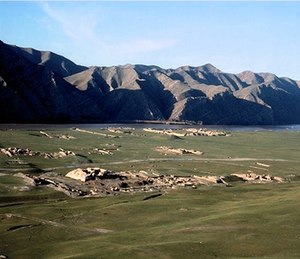Our website is made possible by displaying online advertisements to our visitors.
Please consider supporting us by disabling your ad blocker.
Ai-Khanoum
 The primary sanctuary of Ai-Khanoum, as viewed from the acropolis in the late 1970s.[1] | |
| Location | Takhar Province, Afghanistan |
|---|---|
| Region | Bactria |
| Coordinates | 37°09′53″N 69°24′31″E / 37.16472°N 69.40861°E |
| History | |
| Founded | 3rd century BC |
| Abandoned | 145 BC – 2nd century BC |
| Periods | Hellenistic |
| Site notes | |
| Excavation dates | Between 1964 and 1978 |
| Archaeologists | Paul Bernard |
| Condition | Ruined since antiquity; also plundered by modern looters. |
Ai-Khanoum (/aɪ ˈhɑːnjuːm/, meaning 'Lady Moon';[2] Uzbek: Oyxonim) is the archaeological site of a Hellenistic city in Takhar Province, Afghanistan. The city, whose original name is unknown,[a] was likely founded by an early ruler of the Seleucid Empire and served as a military and economic centre for the rulers of the Greco-Bactrian Kingdom until its destruction c. 145 BC. Rediscovered in 1961, the ruins of the city were excavated by a French team of archaeologists until the outbreak of conflict in Afghanistan in the late 1970s.
The city was probably founded between 300 and 285 BC by an official acting on the orders of Seleucus I Nicator or his son Antiochus I Soter, the first two rulers of the Seleucid dynasty. There is a possibility that the site was known to the earlier Achaemenid Empire, who established a small fort nearby. Ai-Khanoum was originally thought to have been a foundation of Alexander the Great, perhaps as Alexandria Oxiana, but this theory is now considered unlikely. Located at the confluence of the Amu Darya (a.k.a. Oxus) and Kokcha rivers, surrounded by well-irrigated farmland, the city itself was divided between a lower town and a 60-metre-high (200 ft) acropolis. Although not situated on a major trade route, Ai-Khanoum controlled access to both mining in the Hindu Kush and strategically important choke points. Extensive fortifications, which were continually maintained and improved, surrounded the city.
Ai-Khanoum, which may have initially grown in population because of royal patronage and the presence of a mint in the city, lost some importance through the secession of the Greco-Bactrians under Diodotus I (c. 250 BC). Seleucid construction programmes were halted and the city probably became primarily military in function; it may have been a conflict zone during the invasion of Antiochus III (c. 209 – c. 205 BC). Ai-Khanoum began to grow once more under Euthydemus I and his successor Demetrius I, who began to assert control over the northwest Indian subcontinent. Many of the present ruins date from the time of Eucratides I, who substantially redeveloped the city and who may have renamed it Eucratideia, after himself. Soon after his death c. 145 BC, the Greco-Bactrian kingdom collapsed—Ai-Khanoum was captured by Saka invaders and was generally abandoned, although parts of the city were sporadically occupied until the 2nd century AD. Hellenistic culture in the region would persist longer only in the Indo-Greek kingdoms.
While on a hunting trip in 1961, the King of Afghanistan, Mohammed Zahir Shah, rediscovered the city. An archaeological delegation, led by Paul Bernard, unearthed the remains of a huge palace in the lower town, along with a large gymnasium, a theatre capable of holding 6,000 spectators, an arsenal, and two sanctuaries. Several inscriptions were found, along with coins, artefacts, and ceramics. The onset of the Soviet-Afghan War in the late 1970s halted scholarly progress and during the following conflicts in Afghanistan, the site was extensively looted.
- ^ Francfort et al. 2014, p. 20.
- ^ Lecuyot 2020, p. 540.
- ^ Rapin 2007, p. 41; Ptolemy c. 150, 6.11.9.
Cite error: There are <ref group=lower-alpha> tags or {{efn}} templates on this page, but the references will not show without a {{reflist|group=lower-alpha}} template or {{notelist}} template (see the help page).
Previous Page Next Page





